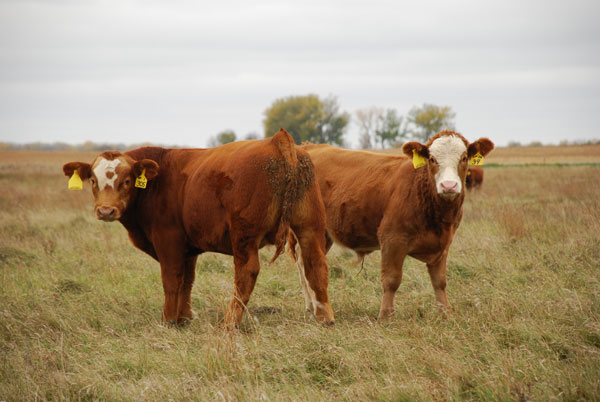Currentness in marketing by feedlots is helping pull carcass weights lower than seasonal expectations, underpinning cattle prices along the way.
April 8, 2017

Feeder steers and heifers traded mostly steady to $7 per cwt lower, according to the Agricultural Marketing Service (AMS). Trade was a touch stronger in the Southeast at steady money to $3 lower. There were also instances of trades at $1-5 more than the previous week.
“Demand was moderate to good for all weight classes,” AMS analysts say. “The higher prices were generally noted on the limited supply of weaned calves suitable for grazing and heavy yearlings with less time expected in the feedlot as buyers are hoping to cash in before slaughter prices fall…Un-weaned fall calves are starting to make their way to the market and buyers are quick to place discounts, especially if calves are too fleshy.”
Although wholesale beef values remain higher than some anticipated, amid the expected seasonal decline, tumbling prices continue to add market pressure.
Choice boxed beef cutout value was $6.90 lower week to week at $207.22 per cwt on Friday. Select was $6.51 lower at $197.49. Choice declined $14.40 over the last two weeks; $18.06 lower for Select.
Between that, reportedly bought-up packers and current feedlots, cash fed cattle trade remained undeveloped at press time on Friday. The first collective glimpse of the stalemate came with the mid-week Fed Cattle Exchange Auction: 3,572 head offered, none traded hands.
There was some scattered country trade at lower prices. For instance, $200 per cwt took some dressed sales in Nebraska and Iowa-Minnesota on Wednesday, followed by $194-$200 the next day; delivery for 1-14 days in both cases. But, there were too few transactions to establish a trend. Fed cattle sales the previous week were at mainly $124-$133 on a live basis and $205-$208 in the beef.
David Anderson, economist with Texas A&M AgriLife Extension Service, notes in a recent issue of In the Cattle Markets that the spring rally in wholesale beef values and cash fed cattle prices helped lift calf and feeder prices.
In the Southern Plains, for example, Anderson points out prices for steers calves (500-600 pounds #1) increased from about $148 per cwt in early January to $165 by the end of March. The price for feeder cattle (steers, 700-800 pounds) increased about $8 per cwt this spring.
Markets are in stronger position
Cattle supplies will continue to increase with the cattle cycle, applying more pressure to prices. It’s also true that markets are more solid in fundamental terms than a year ago. For one thing, currentness in feedlot marketing continues to pull carcass weights lower, beyond seasonal expectations.
“Steer weights (carcass) normally decline into the spring but the slope this year has been steeper than normal,” say analysts with the Steiner Consulting Group in Friday’s Daily Livestock Report. “Since the first week of January, steer weights declined 37 pounds (4.1%). In 2016, steer weights during this 12-week period declined by 1.88% and in 2015 the decline was 2.56%. The last time we saw fed steer weights decline this much from January to the end of March was in 2003, when steer weights declined 5.14% during the same 12-week period.”
Perhaps traders are getting more comfortable with this fundamental reality, given the surge in Live Cattle futures at the end of the week, despite lower wholesale values and undeveloped cash trade.
Feeder Cattle futures closed an average of $2.71 higher week to week on Friday ($1.17-$4.72 higher), growing stronger across the board, and helped along by an average increase of $3.28 over the last two sessions. The exception was 20¢ lower in spot Apr week to week.
Live Cattle futures followed the trend. Except for a dime higher in spot Apr, they were an average of $1.17 higher week to week on Friday (92¢ to $1.45 higher), helped along by positive export news (see “Beef exports continue stronger” below).
“Beef demand will be an especially important factor to monitor as we progress into summer,” says Nevil Speer, in his April cattle market Outlook for BEEF. “Bigger supplies and seasonally softer demand can serve as a double-whammy for prices. However, if the economy is truly picking up and consumer sentiment remains solid, better beef demand could help offset some of that seasonal slump. Time will tell.”
About the Author(s)
You May Also Like





